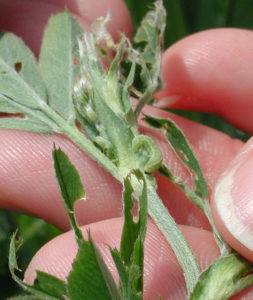First cut took place on most of the forage acres in southern Ontario. Though this is an effective way to manage alfalfa weevil, this year the larvae were quite small at the time of cutting. I’m concerned that the larvae still present will finally be entering the most damaging stages of third and fourth instars during the early stages of crop regrowth. The characteristic symptom is the alfalfa plant not “greening up,” due to weevils feeding on the developing crown buds. The presence of two or more active larvae per crown, or 4–8 larvae per 30 cm by 30 cm (1 ft2) indicates a need to spray the stubble with insecticide.

Alfalfa weevil larvae and feeding injury
Cereal leaf beetles are reaching threshold levels at some locations, despite being quite small and hard to spot. It is important to scout a number of areas of the field, as CLB tends to be unevenly distributed. Wearing light coloured pants while you scout is a good tool to use for detection. If marks or streaks appear on your pant legs after walking through the field, that is the fecal matter that the larvae coat themselves in for protection from the sun, heat and predators. Control is warranted if an average of three larvae per tiller are found before boot stage. One CLB adult or larvae per stem warrants control after boot but prior to heading. If significant feeding is taking place on the flag leaf in the early heading stages, control may be warranted.